
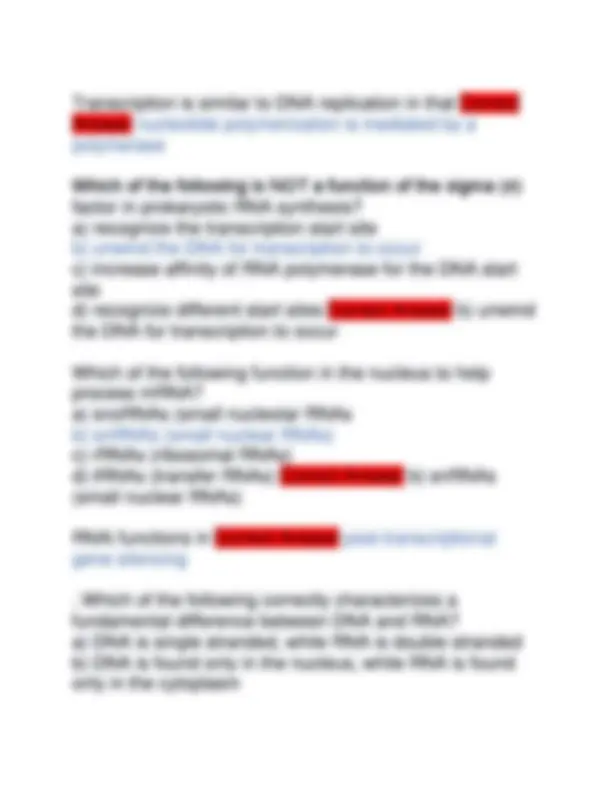
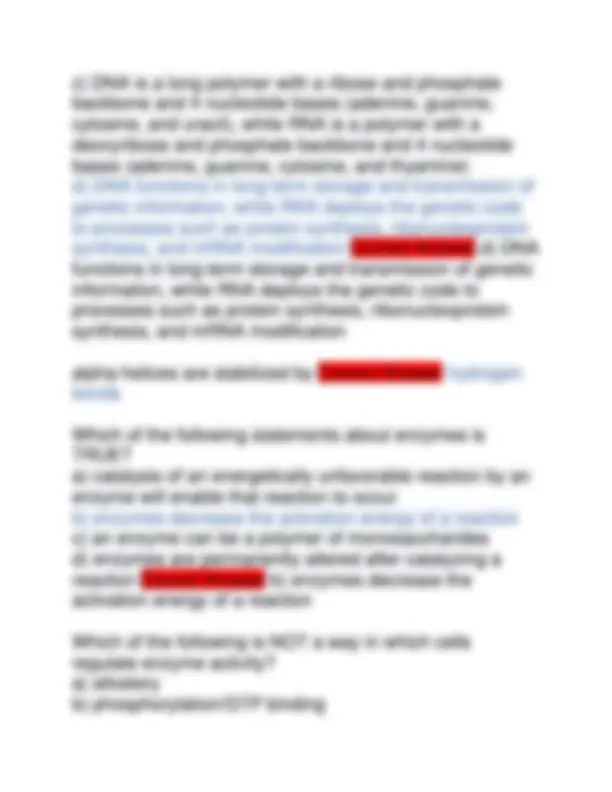
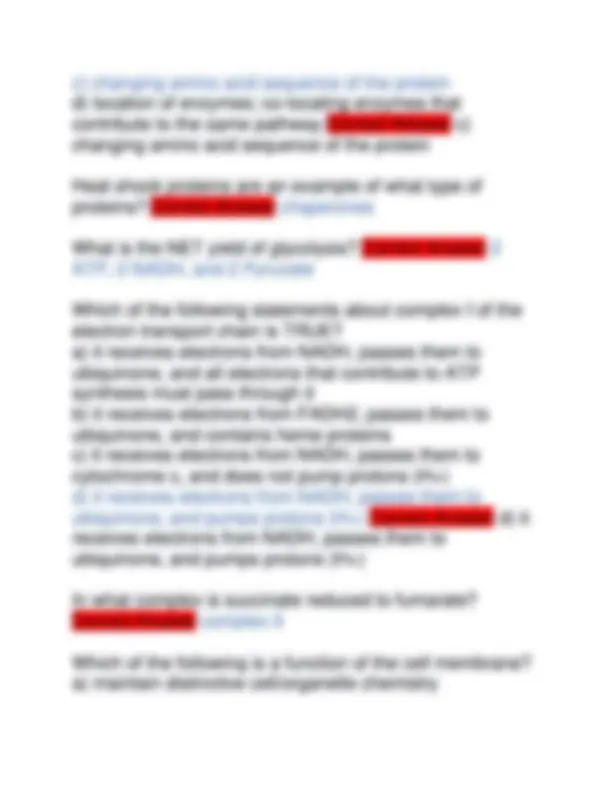
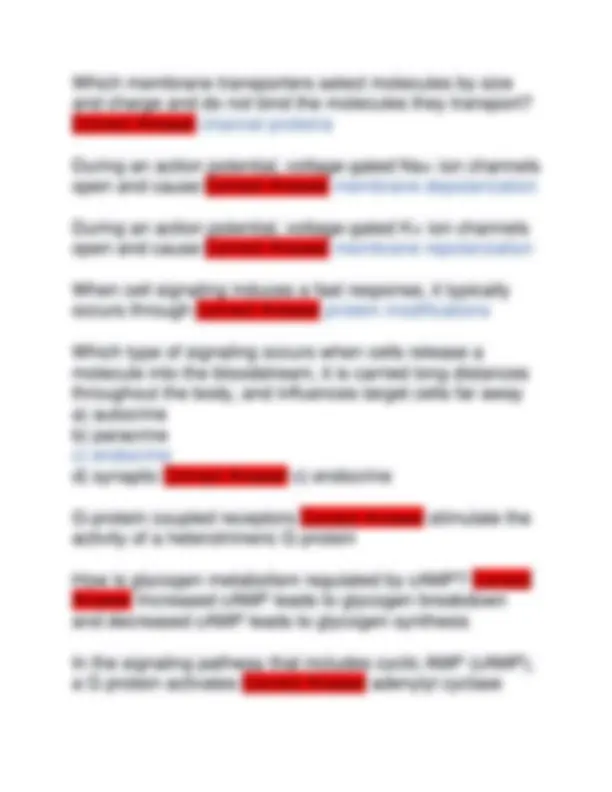
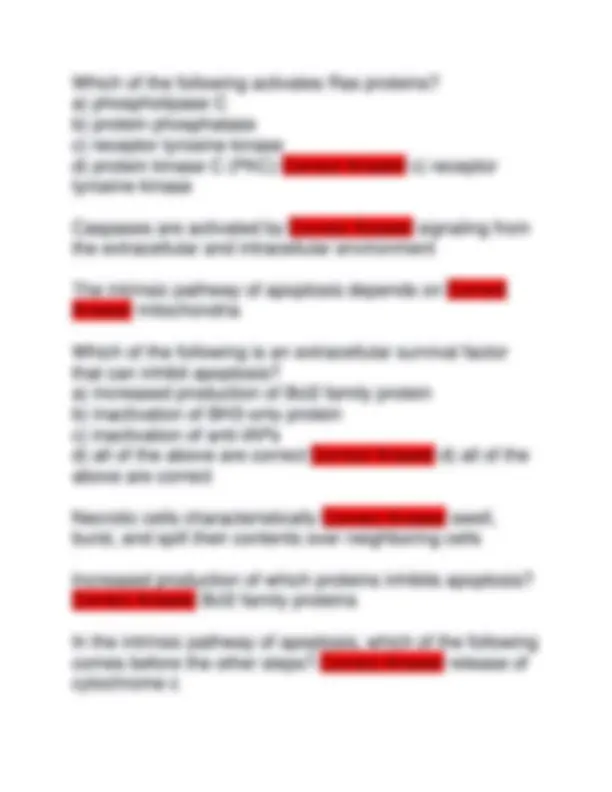
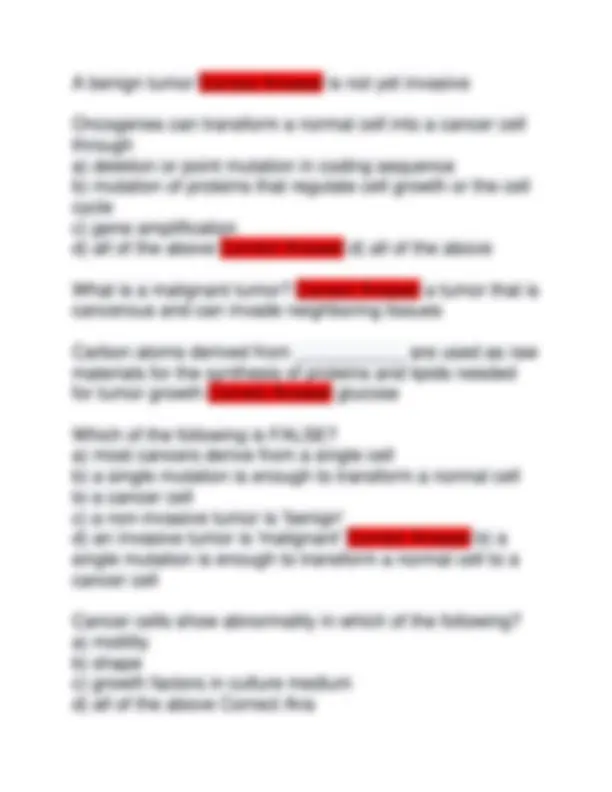
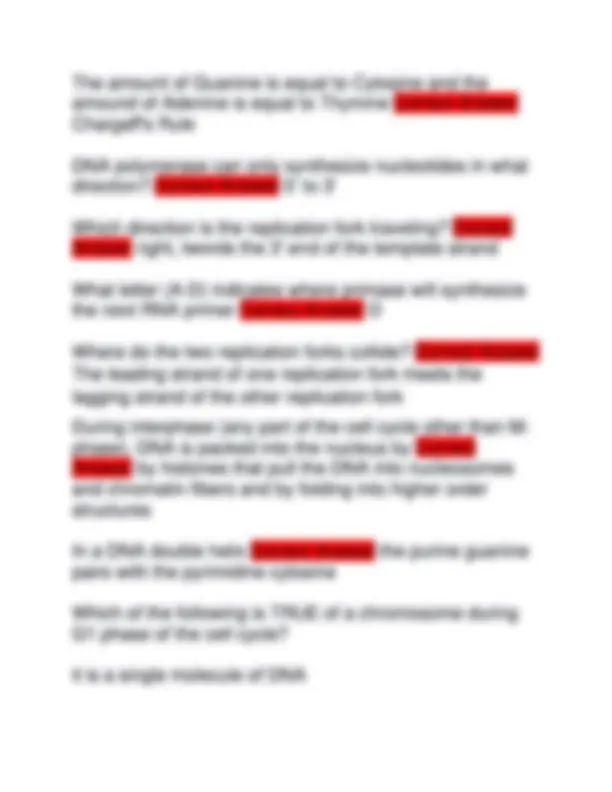
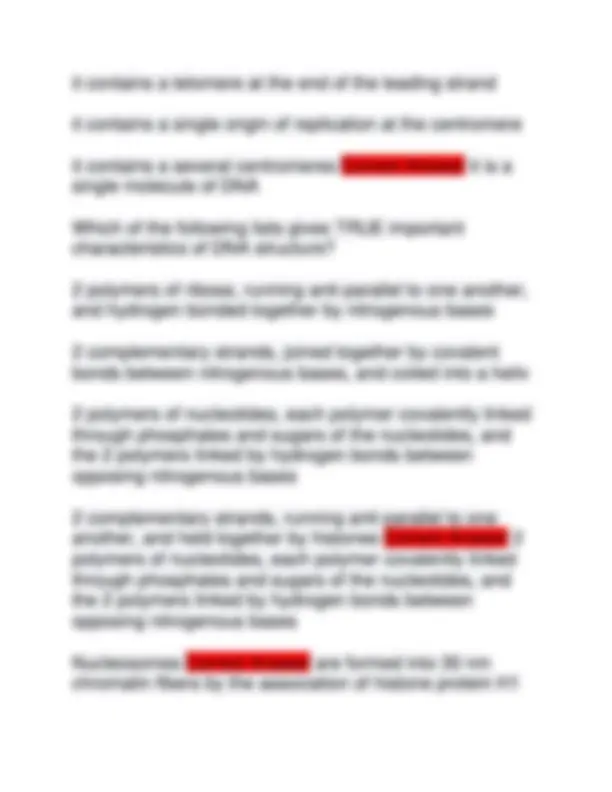
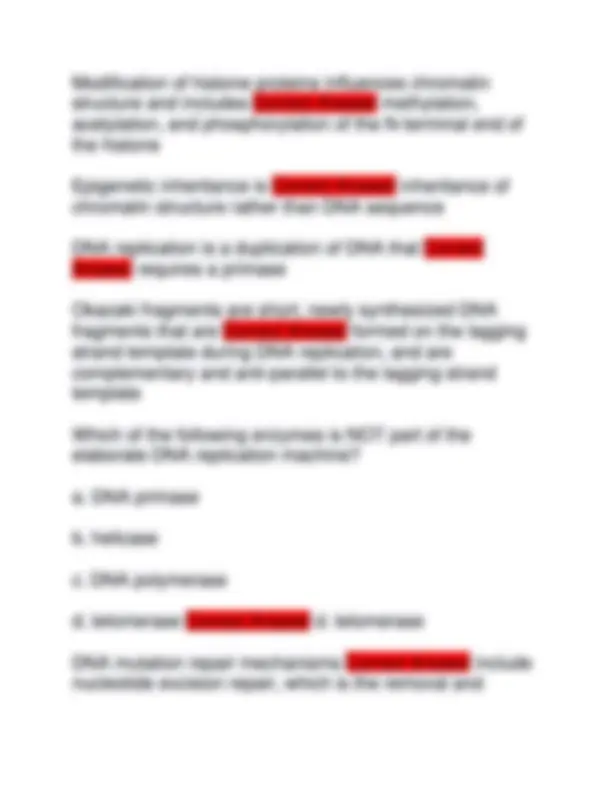
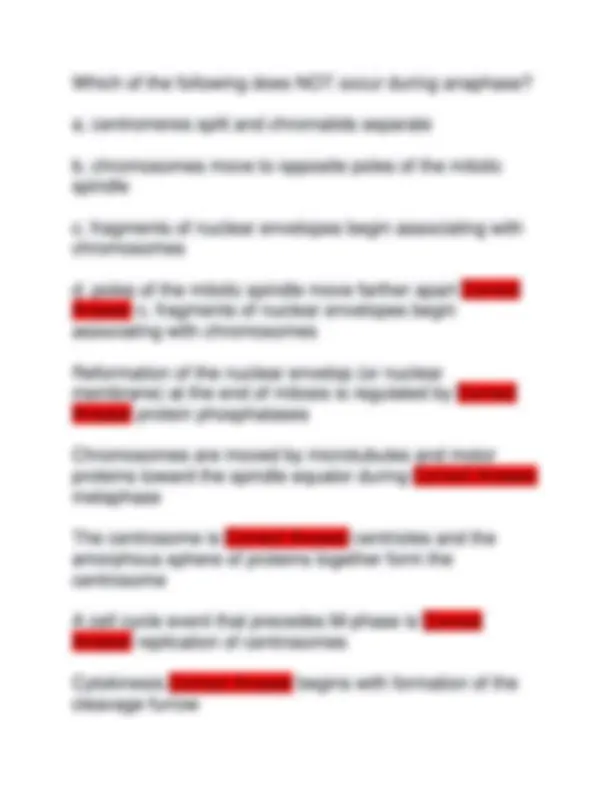
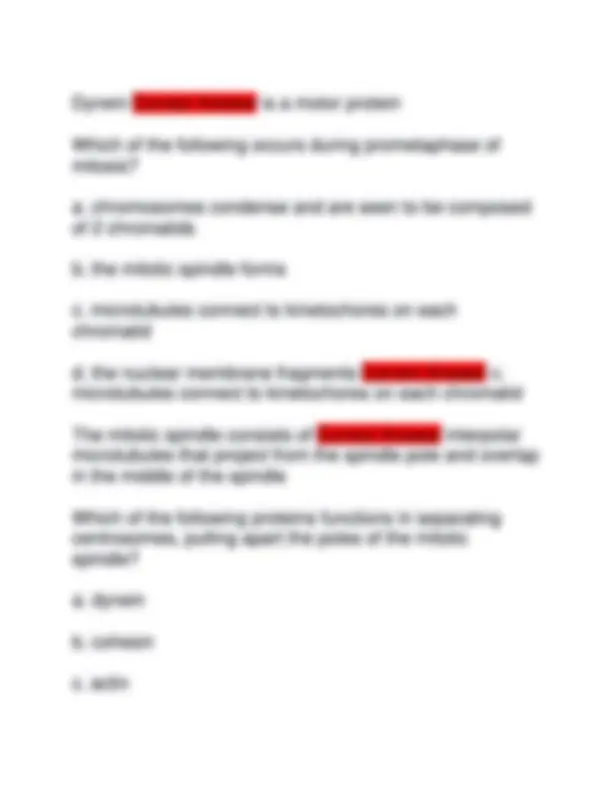
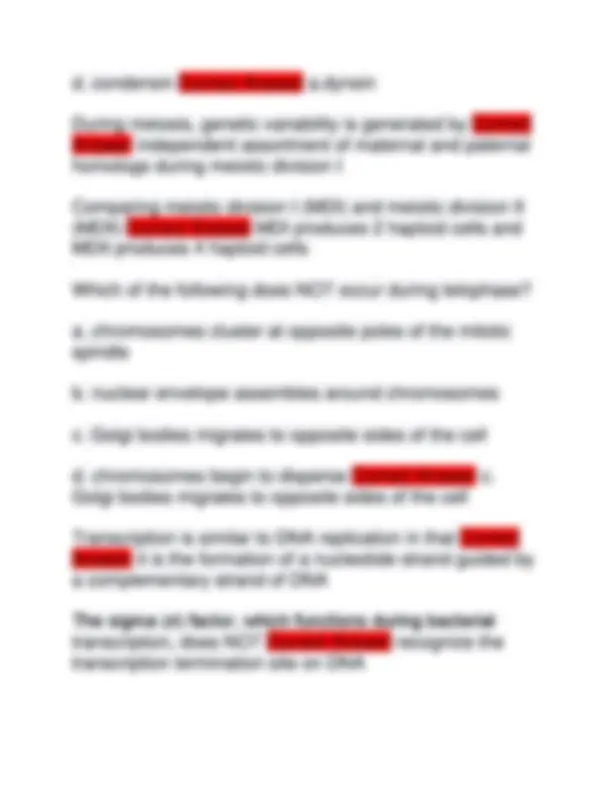
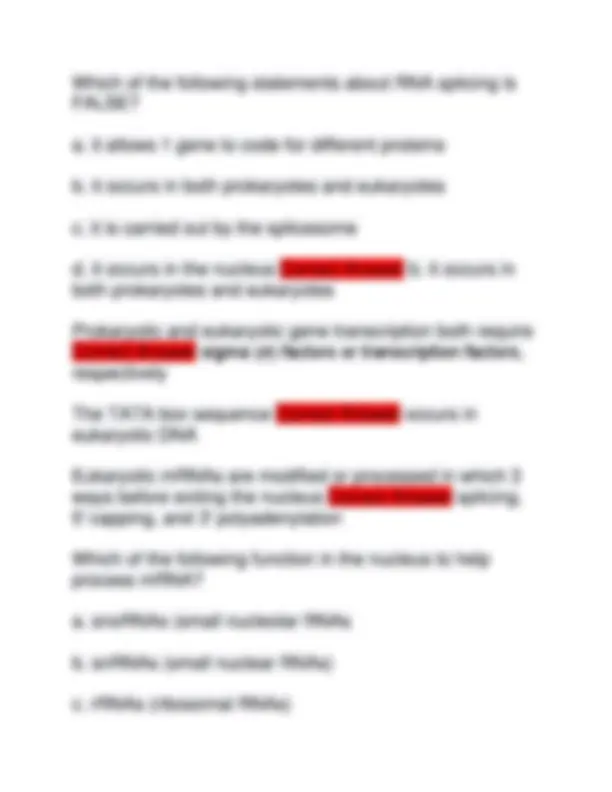
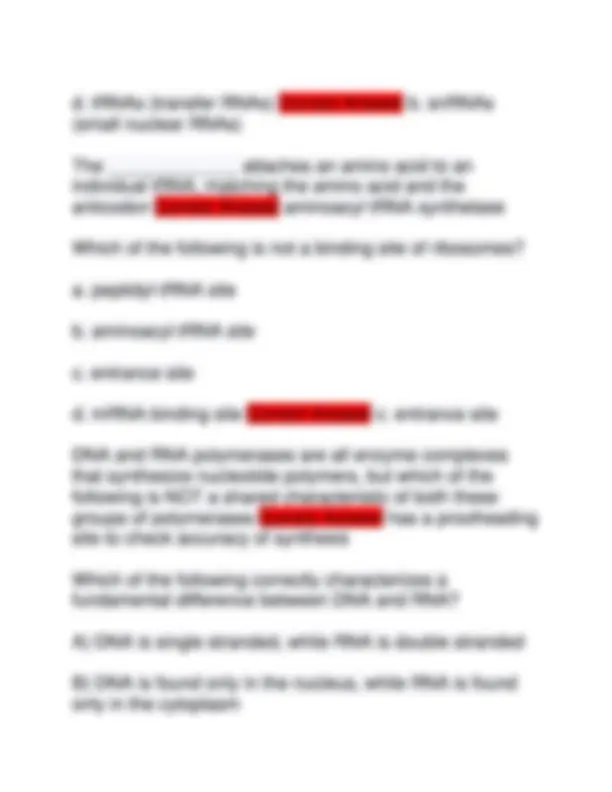
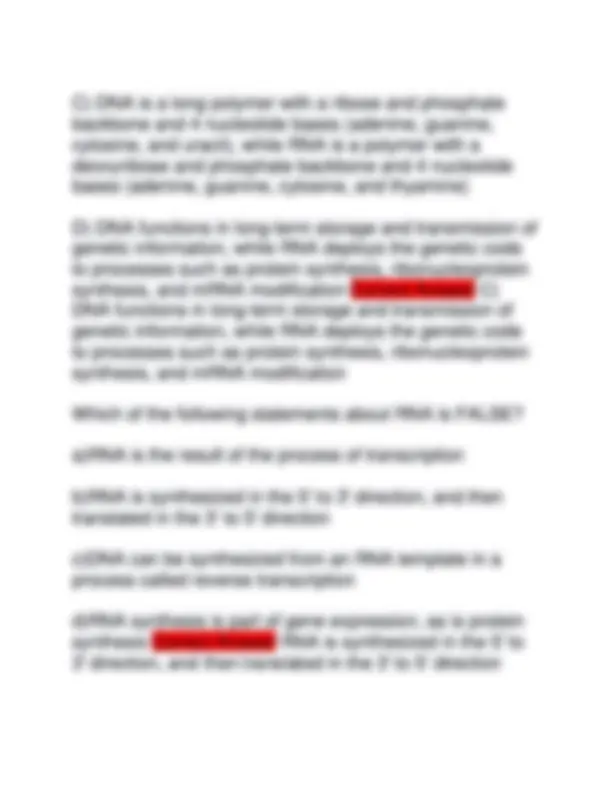
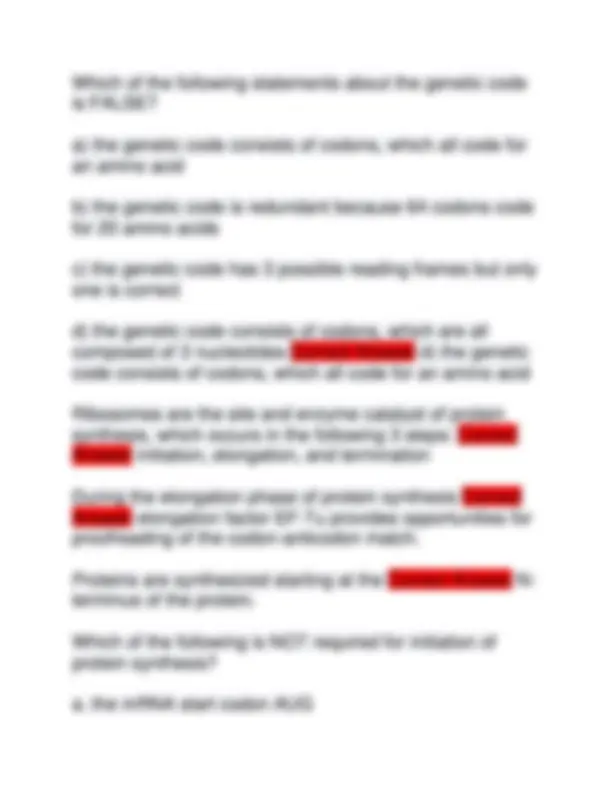
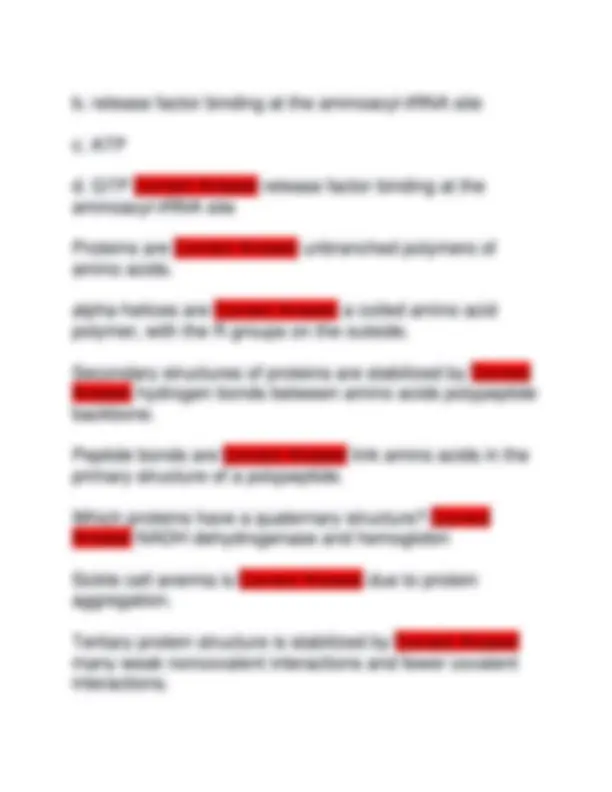
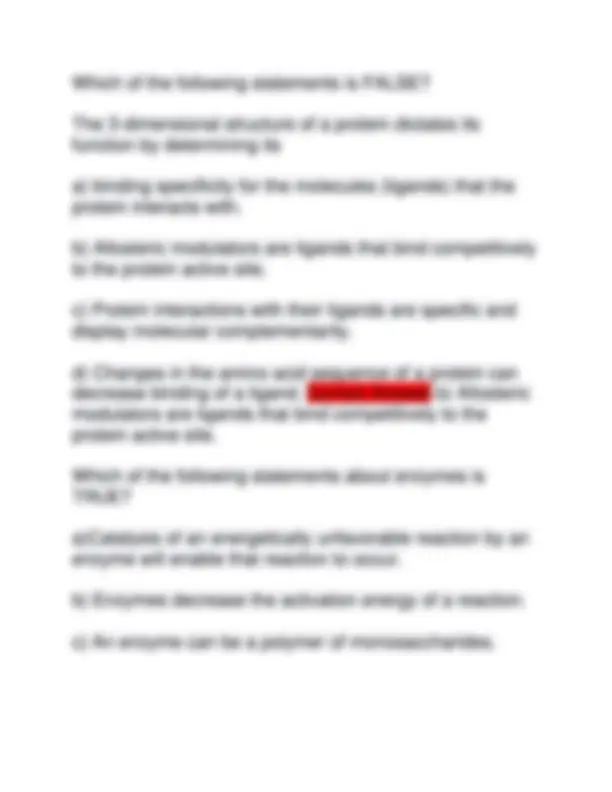
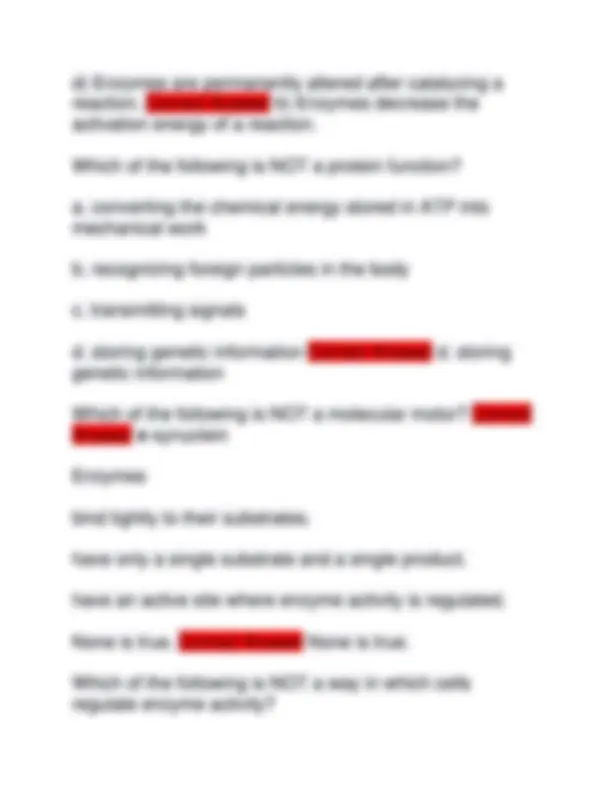

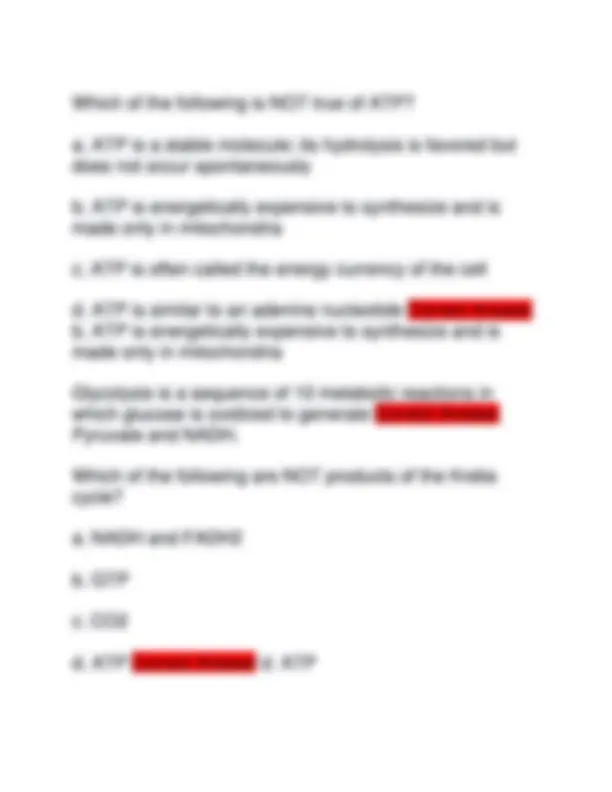
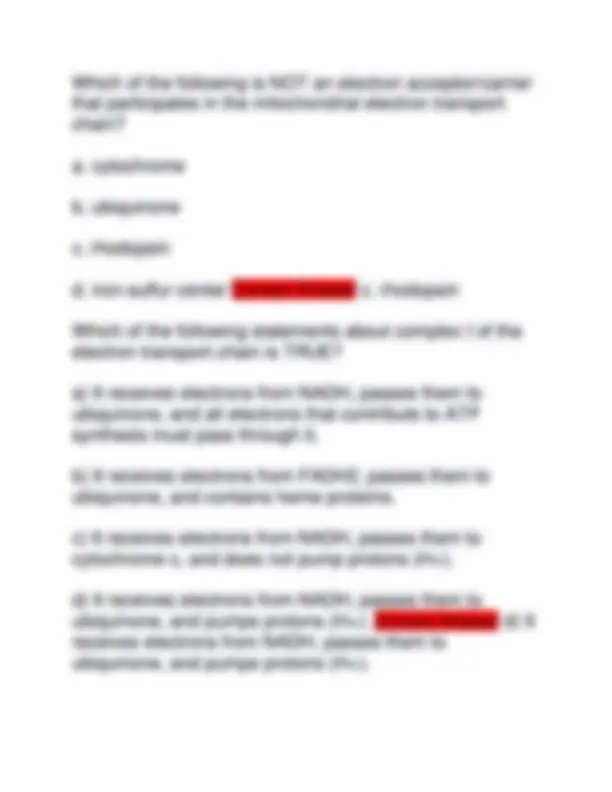
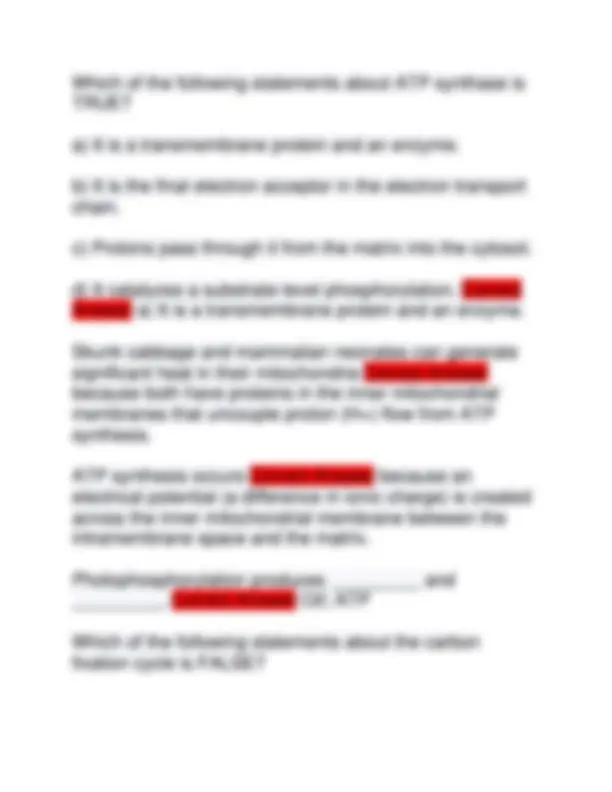
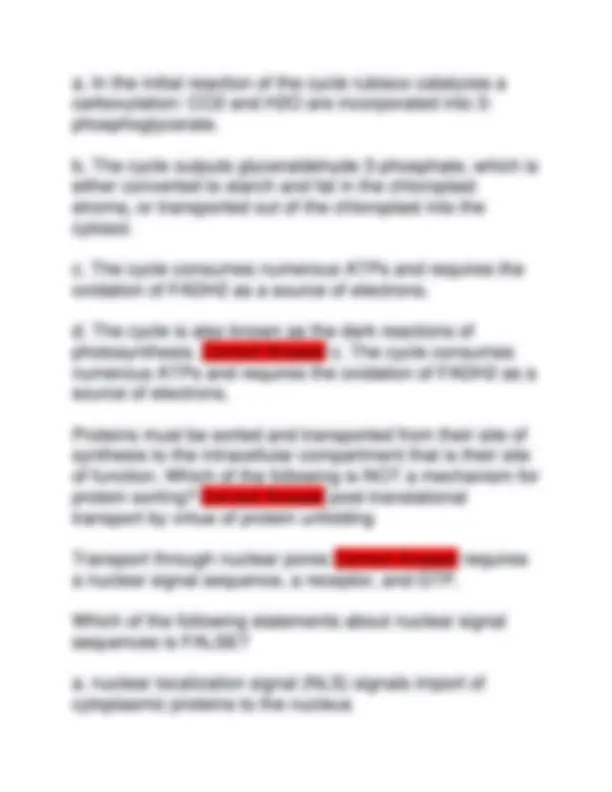
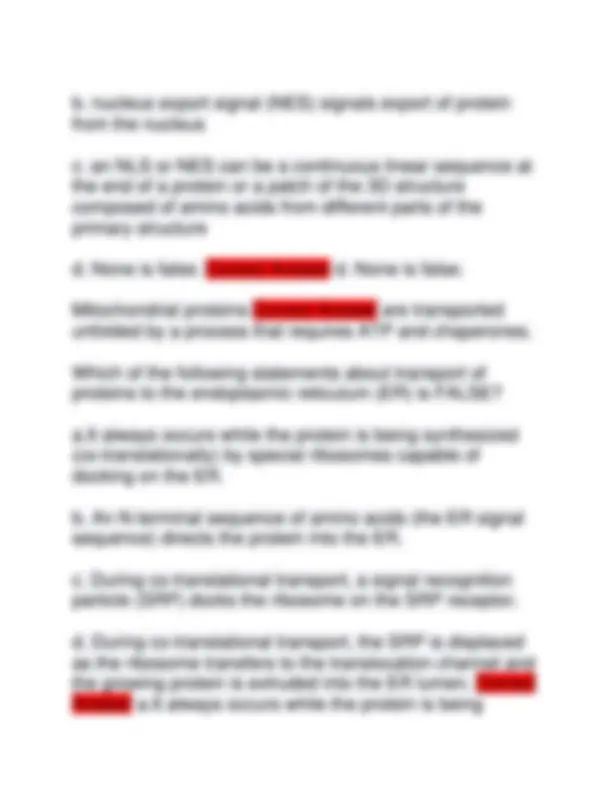
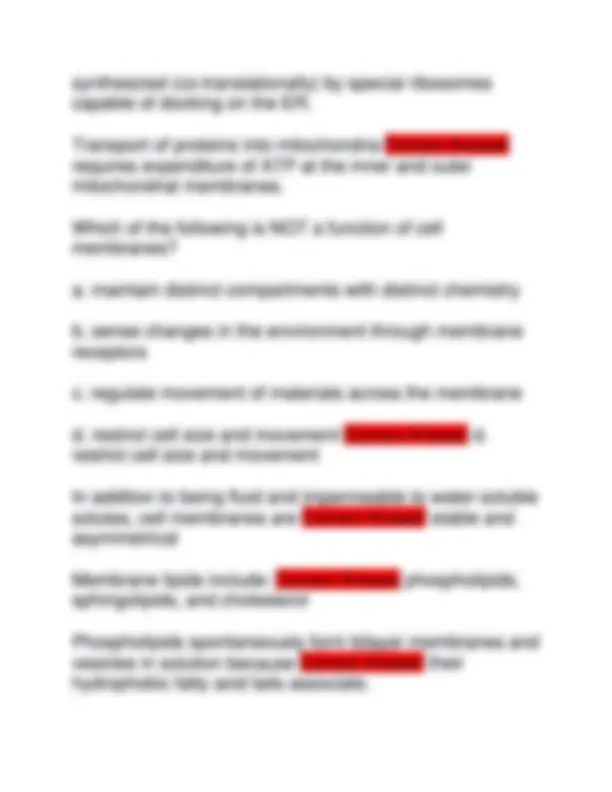
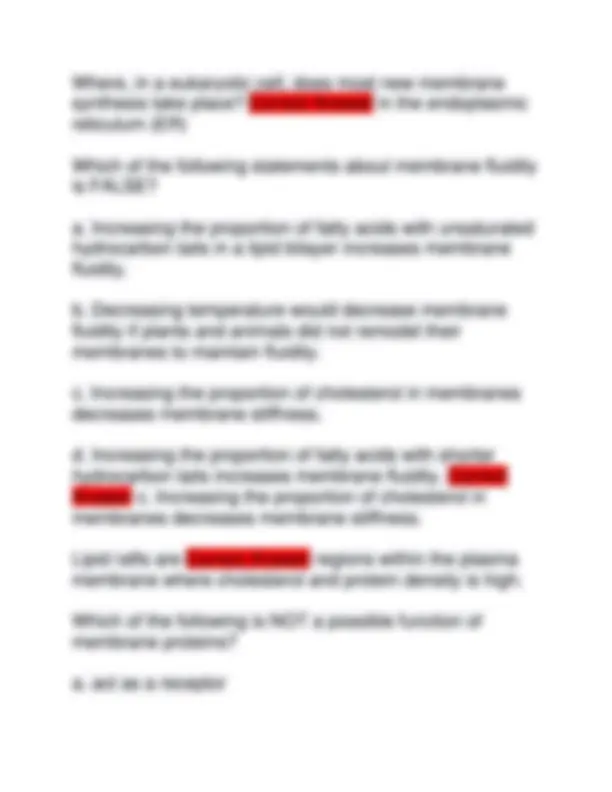
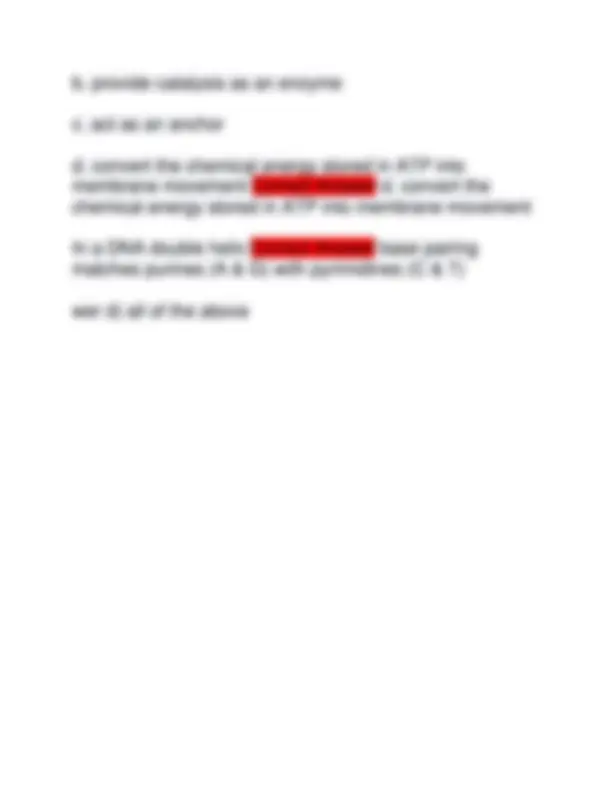


Study with the several resources on Docsity

Earn points by helping other students or get them with a premium plan


Prepare for your exams
Study with the several resources on Docsity

Earn points to download
Earn points by helping other students or get them with a premium plan
Community
Ask the community for help and clear up your study doubts
Discover the best universities in your country according to Docsity users
Free resources
Download our free guides on studying techniques, anxiety management strategies, and thesis advice from Docsity tutors
ASU BIO 340 FINAL EXAM NEWEST 2025 EXAM QUESTIONS AND DETAILED CORRECT ANSWERS | A+ GRADE
Typology: Exams
1 / 36

This page cannot be seen from the preview
Don't miss anything!





























In nucleic acids, nitrogenous bases are linked by ________ bonds, which are ________ Correct Answer hydrogen; weak What is a limiting factor on the rate of replication? Correct Answer the rate of initiation Which of the following lists gives TRUE important characteristics of DNA structure? a) 2 polymers of ribose, running anti-parallel to one another, and hydrogen bonded together by nitrogenous bases b) 2 complementary strands, joined together by covalent bonds between nitrogenous bases, and coiled into a helix c) 2 polymers of nucleotides, each polymer covalently linked through phosphates and sugars of the nucleotides, and the 2 polymers linked by hydrogen bonds between opposing nitrogenous bases d) 2 complementary strands, running anti-parallel to one another, and held together by histones Correct Answer c) 2 polymers of nucleotides, each polymer covalently linked through phosphates and sugars of the nucleotides, and the 2 polymers linked by hydrogen bonds between opposing nitrogenous bases
Human DNA has multiple origins of replication that are Correct Answer locations where the double-stranded DNA is opened and replication proceeds in 2 directions with 2 replication forks
. The cell cycle is regulated by a) G1/S-cyclins that commits the cell to division b) S-cyclins that help stimulate chromosome duplication or DNA replication c) M-cyclins that stimulate entry into mitosis d) all of the above Correct Answer d) all of the above When in the cell cycle does the centrosome cycle begin? Correct Answer S-phase . During meiosis, genetic variability is generated by a) crossing over of non-sister chromatids at chiasmata during prophase I b) independent assortment of maternal and paternal homologs during meiotic division I c) both a and b are correct d) none of the above Correct Answer c) both a and b are correct Which of the following proteins functions in separating centrosomes, pulling apart the poles of the mitotic spindle? a) dynein b) kinesin c) actin d) condensin Correct Answer a) dynein
c) DNA is a long polymer with a ribose and phosphate backbone and 4 nucleotide bases (adenine, guanine, cytosine, and uracil), while RNA is a polymer with a deoxyribose and phosphate backbone and 4 nucleotide bases (adenine, guanine, cytosine, and thyamine) d) DNA functions in long-term storage and transmission of genetic information, while RNA deploys the genetic code to processes such as protein synthesis, ribonucleoprotein synthesis, and mRNA modification Correct Answer d) DNA functions in long-term storage and transmission of genetic information, while RNA deploys the genetic code to processes such as protein synthesis, ribonucleoprotein synthesis, and mRNA modification alpha-helices are stabilized by Correct Answer hydrogen bonds Which of the following statements about enzymes is TRUE? a) catalysis of an energetically unfavorable reaction by an enzyme will enable that reaction to occur b) enzymes decrease the activation energy of a reaction c) an enzyme can be a polymer of monosaccharides d) enzymes are permanently altered after catalyzing a reaction Correct Answer b) enzymes decrease the activation energy of a reaction Which of the following is NOT a way in which cells regulate enzyme activity? a) allostery b) phosphorylation/GTP binding
c) changing amino acid sequence of the protein d) location of enzymes; co-locating enzymes that contribute to the same pathway Correct Answer c) changing amino acid sequence of the protein Heat shock proteins are an example of what type of proteins? Correct Answer chaperones What is the NET yield of glycolysis? Correct Answer 2 ATP, 2 NADH, and 2 Pyruvate Which of the following statements about complex I of the electron transport chain is TRUE? a) it receives electrons from NADH, passes them to ubiquinone, and all electrons that contribute to ATP synthesis must pass through it b) it receives electrons from FADH2, passes them to ubiquinone, and contains heme proteins c) it receives electrons from NADH, passes them to cytochrome c, and does not pump protons (H+) d) it receives electrons from NADH, passes them to ubiquinone, and pumps protons (H+) Correct Answer d) it receives electrons from NADH, passes them to ubiquinone, and pumps protons (H+) In what complex is succinate reduced to fumarate? Correct Answer complex II Which of the following is a function of the cell membrane? a) maintain distinctive cell/organelle chemistry
Phospholipids have a ________ head and a ________ tail Correct Answer hydrophilic, hydrophobic Which of the following are membrane lipids? a) phospholipids b) sphingolipids c) cholesterol d) all of the above Correct Answer d) all of the above What is an antiporter? Correct Answer an integral membrane protein transport two different molecules across the cell membrane in opposite directions Which of the following statements about membrane transport is FALSE? a) passive transport is dependent on concentration gradients and membrane potential b) electrical and chemical gradients can work with or work against passive transport c) facilitated diffusion moves molecules up their concentration gradient d) all of the above Correct Answer c) facilitated diffusion moves molecules up their concentration gradient What is a symporter? Correct Answer an integral membrane protein that transports two types of molecules across the cell membrane
Which membrane transporters select molecules by size and charge and do not bind the molecules they transport? Correct Answer channel proteins During an action potential, voltage-gated Na+ ion channels open and cause Correct Answer membrane depolarization During an action potential, voltage-gated K+ ion channels open and cause Correct Answer membrane repolarization When cell signaling induces a fast response, it typically occurs through Correct Answer protein modifications Which type of signaling occurs when cells release a molecule into the bloodstream, it is carried long distances throughout the body, and influences target cells far away a) autocrine b) paracrine c) endocrine d) synaptic Correct Answer c) endocrine G-protein coupled receptors Correct Answer stimulate the activity of a heterotrimeric G protein How is glycogen metabolism regulated by cAMP? Correct Answer Increased cAMP leads to glycogen breakdown and decreased cAMP leads to glycogen synthesis In the signaling pathway that includes cyclic AMP (cAMP), a G protein activates Correct Answer adenylyl cyclase
A benign tumor Correct Answer is not yet invasive Oncogenes can transform a normal cell into a cancer cell through a) deletion or point mutation in coding sequence b) mutation of proteins that regulate cell growth or the cell cycle c) gene amplification d) all of the above Correct Answer d) all of the above What is a malignant tumor? Correct Answer a tumor that is cancerous and can invade neighboring tissues Carbon atoms derived from ___________ are used as raw materials for the synthesis of proteins and lipids needed for tumor growth Correct Answer glucose Which of the following is FALSE? a) most cancers derive from a single cell b) a single mutation is enough to transform a normal cell to a cancer cell c) a non-invasive tumor is 'benign' d) an invasive tumor is 'malignant' Correct Answer b) a single mutation is enough to transform a normal cell to a cancer cell Cancer cells show abnormality in which of the following? a) motility b) shape c) growth factors in culture medium d) all of the above Correct Ans
What is the name of the bond that joins one nucleotide to another in a DNA strand? Correct Answer phosphodiester bond In which strand of DNA would you expect to find more RNA during replication? Correct Answer The lagging strand In a DNA nucleotide, which carbon in the deoxyribose binds to the phosphate group? Correct Answer 5' Protein translation, RNA transcription & Hybridization all depend on what? Correct Answer Complementary Base Pairing Where does chromosome shortening occur? Correct Answer nuclei Where does chromosome shortening NOT occur? Correct Answer germ line - where sperm and eggs are dervied A double helix is made up of... Correct Answer two complementary strands What is transcription? Correct Answer The process of making RNA from DNA What is translation? Correct Answer the decoding of an mRNA message into a protein
The amount of Guanine is equal to Cytosine and the amound of Adenine is equal to Thymine Correct Answer Chargaff's Rule DNA polymerase can only synthesize nucleotides in what direction? Correct Answer 5' to 3' Which direction is the replication fork traveling? Correct Answer right, twords the 3' end of the template strand What letter (A-D) indicates where primase will synthesize the next RNA primer Correct Answer D Where do the two replication forks collide? Correct Answer The leading strand of one replication fork meets the lagging strand of the other replication fork During interphase (any part of the cell cycle other than M- phase), DNA is packed into the nucleus by Correct Answer by histones that pull the DNA into nucleosomes and chromatin fibers and by folding into higher order structures In a DNA double helix Correct Answer the purine guanine pairs with the pyrimidine cytosine Which of the following is TRUE of a chromosome during G1 phase of the cell cycle? it is a single molecule of DNA
it contains a telomere at the end of the leading strand it contains a single origin of replication at the centromere it contains a several centromeres Correct Answer it is a single molecule of DNA Which of the following lists gives TRUE important characteristics of DNA structure? 2 polymers of ribose, running anti-parallel to one another, and hydrogen bonded together by nitrogenous bases 2 complementary strands, joined together by covalent bonds between nitrogenous bases, and coiled into a helix 2 polymers of nucleotides, each polymer covalently linked through phosphates and sugars of the nucleotides, and the 2 polymers linked by hydrogen bonds between opposing nitrogenous bases 2 complementary strands, running anti-parallel to one another, and held together by histones Correct Answer 2 polymers of nucleotides, each polymer covalently linked through phosphates and sugars of the nucleotides, and the 2 polymers linked by hydrogen bonds between opposing nitrogenous bases Nucleosomes Correct Answer are formed into 30 nm chromatin fibers by the association of histone protein H
replacement of segments of DNA that contain errors such as pyrimidine dimers CRISPR Cas9 Correct Answer is a molecular complex, composed of a synthetic guide RNA molecule and Cas nuclease, and used for experimental gene editing Origins of replication in human DNA are Correct Answer locations where the double-stranded DNA is opened and replication proceeds in 2 directions with 2 replication forks Which of the following statements about DNA replication is FALSE? a. DNA replication is semi-conservative; DNA strands remain intact and serve as templates during replication b. DNA replication proceeds 5' to 3'; nucleotides are added only at the 3' end of a DNA strand c. helicase, DNA primase, and DNA polymerase are key enzymes in DNA replication d. telomerase initiates DNA replication, which begins at the ends of the chromosomes Correct Answer d. telomerase initiates DNA replication, which begins at the ends of the chromosomes Which of the following is FALSE about the cell cycle?
a. it is controlled by constantly active cyclin-dependent kinases (Cdks) b. it usually consists of 4 phases in eukaryotic cells c. it has checkpoints that ensure the cell cycle does not progress unless all conditions are favorable d. it includes a phase of DNA replication that precedes cell division Correct Answer a. it is controlled by constantly active cyclin-dependent kinases (Cdks) Which of the following occurs during M-phase but is NOT controlled by M-Cdk? a. condensation of chromosomes b. phosphorylation of lamins leading to breakdown of the nuclear envelope c. formation of the mitotic spindle apparatus d. activation of proteolytic enzymes that break cohesin and allow separation of sister chromatids Correct Answer d. activation of proteolytic enzymes that break cohesin and allow separation of sister chromatids Chromosomes are aligned on the equator of the mitotic spindle and attached, via kinetochore microtubules, to the centrosomes Correct Answer metaphase
Dynein Correct Answer is a motor protein Which of the following occurs during prometaphase of mitosis? a. chromosomes condense and are seen to be composed of 2 chromatids b. the mitotic spindle forms c. microtubules connect to kinetochores on each chromatid d. the nuclear membrane fragments Correct Answer c. microtubules connect to kinetochores on each chromatid The mitotic spindle consists of Correct Answer interpolar microtubules that project from the spindle pole and overlap in the middle of the spindle Which of the following proteins functions in separating centrosomes, pulling apart the poles of the mitotic spindle? a. dynein b. cohesin c. actin
d. condensin Correct Answer a.dynein During meiosis, genetic variability is generated by Correct Answer independent assortment of maternal and paternal homologs during meiotic division I Comparing meiotic division I (MDI) and meiotic division II (MDII) Correct Answer MDI produces 2 haploid cells and MDII produces 4 haploid cells Which of the following does NOT occur during telophase? a. chromosomes cluster at opposite poles of the mitotic spindle b. nuclear envelope assembles around chromosomes c. Golgi bodies migrates to opposite sides of the cell d. chromosomes begin to disperse Correct Answer c. Golgi bodies migrates to opposite sides of the cell Transcription is similar to DNA replication in that Correct Answer it is the formation of a nucleotide strand guided by a complementary strand of DNA The sigma (σ) factor, which functions during bacterial transcription, does NOT Correct Answer recognize the transcription termination site on DNA